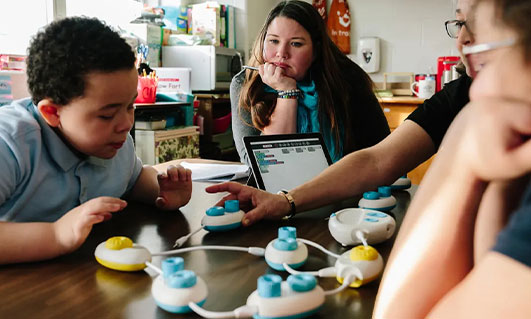
In today’s tech-driven world, education is undergoing a significant transformation, and the inclusion of smart devices in classrooms is making learning more accessible to students of all abilities. For visually impaired students, this shift has opened new doors, enabling them to engage with their studies in ways previously unimaginable. One such innovative tool that is reshaping the learning experience is the Braille notetaker. In this blog, we’ll explore how Braille notetakers are enhancing education for visually impaired students and creating more inclusive learning environments.
What Are Braille Notetakers?
A Braille notetaker is a portable electronic device that allows visually impaired students to take notes, access digital information, and complete tasks in Braille. These devices feature a refreshable Braille display, a Braille keyboard, and sometimes even speech output. They can connect to computers, smartphones, and other devices, making them versatile tools that integrate seamlessly into today’s tech-savvy classrooms.
How Braille Notetakers Support Learning
1. Fostering Independence
One of the key benefits of Braille notetakers is the independence they provide visually impaired students. Rather than relying on teachers or classmates to read aloud or take notes for them, students can use the notetaker to record lectures, input their thoughts, and retrieve information. This sense of autonomy empowers students to take control of their learning, improving confidence and engagement in the classroom.
2. Access to Digital Resources
In modern education, students are increasingly required to interact with digital resources, whether through e-books, online articles, or multimedia presentations. Braille notetakers allow visually impaired students to access these digital materials in Braille, leveling the playing field and ensuring that they do not miss out on critical information. Many Braille notetakers also come with internet access, enabling students to research and gather information independently.
3. Efficient Note-Taking
Taking notes is an essential skill for academic success, but traditional methods of Braille note-taking, such as using paper and slate, can be slow and cumbersome. Braille notetakers streamline this process, allowing students to type notes quickly and efficiently. This real-time note-taking ability enables them to participate more actively in lessons and discussions, keeping pace with their sighted peers.
4. Enhanced Collaboration
With Braille notetakers, visually impaired students can easily share their work with teachers and classmates. Many devices can convert Braille text into digital formats like Word documents or PDFs, making it simple to submit assignments or collaborate on group projects. This fosters a more inclusive classroom dynamic where all students, regardless of their visual abilities, can contribute equally.
5. Accessibility Features
Most Braille notetakers come equipped with additional accessibility features such as screen readers, audio output, and tactile feedback. These features allow students to interact with the device in multiple ways, catering to their individual preferences and needs. For students with both visual and auditory impairments, the tactile Braille display becomes especially vital in their learning process.
The Impact on Educational Outcomes
The introduction of Braille notetakers into classrooms has been shown to have a profound impact on the academic success of visually impaired students. With these devices, students are not only able to keep up with the curriculum but also to excel in ways that might not have been possible before. By providing access to information and improving participation, Braille notetakers help students develop critical thinking, problem-solving, and literacy skills.
Challenges and Considerations
While Braille notetakers offer many advantages, there are challenges to their widespread adoption. The cost of these devices can be prohibitive for some families or schools, though many organizations and government programs offer grants or financial assistance. Additionally, teachers and support staff must be trained to use and integrate Braille notetakers into their teaching strategies effectively.
Looking Toward the Future
As technology continues to evolve, so too will the capabilities of Braille notetakers and other assistive devices. With advancements in artificial intelligence, cloud computing, and real-time data sharing, we can expect future devices to offer even greater accessibility and functionality. These innovations will further break down barriers for visually impaired students, ensuring that they have the tools they need to succeed academically and beyond.
Conclusion
Braille notetakers are transforming classrooms into more inclusive spaces where visually impaired students can thrive alongside their peers. By providing independence, access to digital resources, and efficient note-taking, these devices are enhancing learning experiences and opening new opportunities for academic and personal growth. As educators and communities continue to embrace smart technology, the future looks bright for students of all abilities.
Incorporating Braille notetakers into classrooms is not just about accessibility; it’s about empowering visually impaired students to achieve their full potential and creating a more equitable educational system for all.





